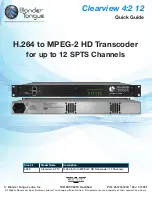
OM-CP-RF Series Operations Manual
Omega Engineering, Inc.
Revised 04/07/05
Page 9 of 18
PREVENTING COLLISIONS WITH PRIME NUMBERS
As mentioned in the previous section, prime numbers can be helpful in preventing
collisions, allowing the maximum amount of data to be received from every transmitter.
This section will outline the steps to follow to select the best transmission intervals, and
provide a worked example.
Using prime numbers is advantageous because the common multiples of two prime
numbers are farther apart than the multiples of two nearby non-primes. (For example, the
numbers 8 and 12 have a common multiple at 24, 48, 72, etc., while 7 and 11 have their
first common multiple at 77.) So, if two transmitters were set up to transmit at 8 and 12
minutes respectively, a collision (and a lost transmission) would occur every 24 minutes,
much more often than if they were set up to transmit at 7 and 11 minutes. When expanding
to 3 or more transmitters, this property is even more pronounced.
The size of the prime number matters as well. For larger prime numbers, fewer collisions
will occur in a given amount of time.
Finally, to minimize the impact of the collisions that do occur, the transmitter should be
configured to transmit the same data at least twice for every reading. This can be
accomplished using the “Return most recently recorded data only” option in the Wireless
Configuration dialog. For two transmitter systems, this ensures that every reading will have
at least one clear slot for transmission. If two transmitters collide during the first
transmission attempt, they cannot possibly collide during the second (they are scheduled to
select different sots for the second attempt). For three or more transmitters, it is possible to
collide with one transmitter on the first attempt and another on the second attempt, but the
number of these “sequential collisions” is very small.
The general procedure for selecting transmission intervals follows below. It assumes that
all the transmitters will be recording data at the same rate.
1.
Determine the number of transmitters
– Determine the number of points that
need to be monitored, and select the transmitters that will cover those points most
efficiently.
2.
Determine the reading interval
– The reading interval selected for the devices
should be the longest interval that will provide the data needed for the application.
3.
Select the prime numbers
– The transmission intervals must always be a multiple
of 10 seconds. So, divide the reading interval (in seconds) by 20, and pick the
largest prime numbers that are less than this value. This ensures that there will
always be at least two transmission slots per reading for each transmitter. Prime
numbers in the necessary range are listed in Table 1.
4.
Assign the transmission intervals
– Multiply the prime numbers selected in step 3
by 10, and assign them to the transmitters. If some transmitters are monitoring
more critical data than others, they may be assigned the smaller or larger numbers
depending on the application. If the smallest numbers are substantially less than half
the reading interval (e.g. 130 seconds for a 10 minute reading interval), assign them
to the more critical transmitters to increase the number of transmissions per
reading. If the smaller numbers are close to half the reading interval, assign the
Summary of Contents for OM-CP-RF Series
Page 1: ......








































